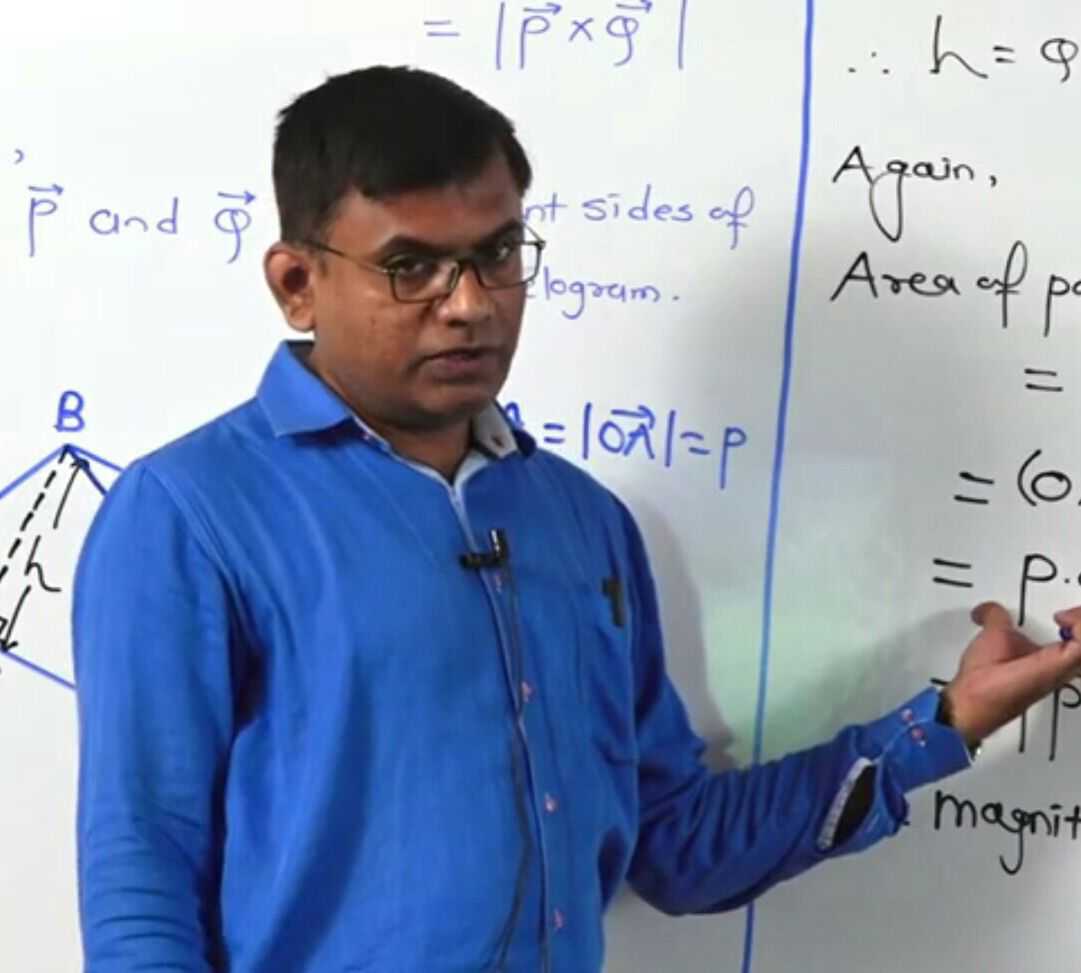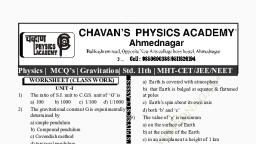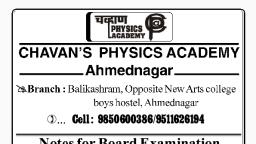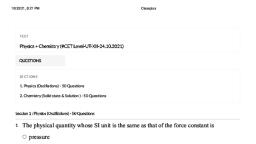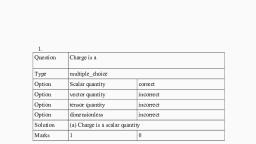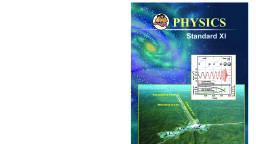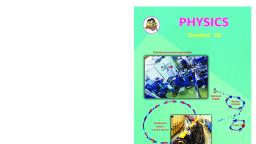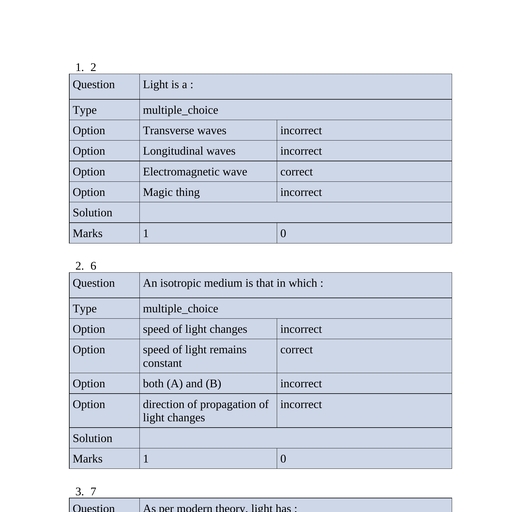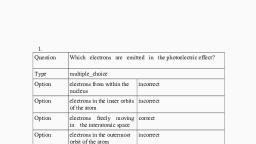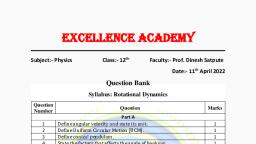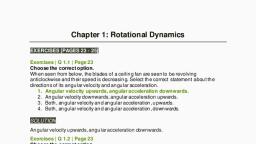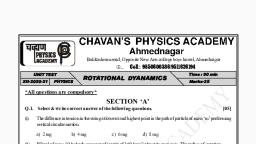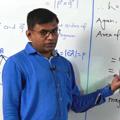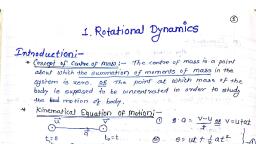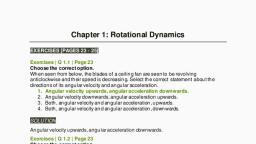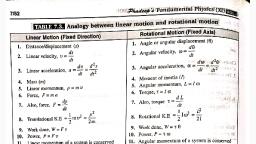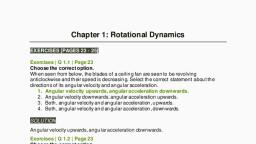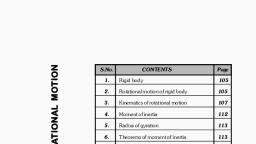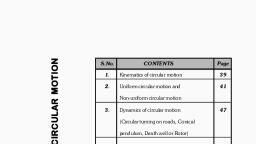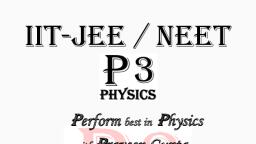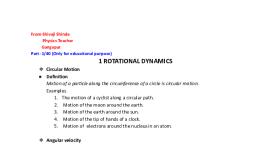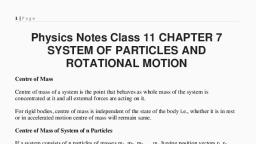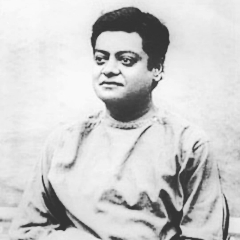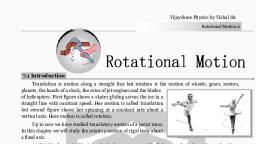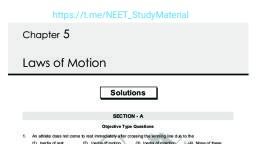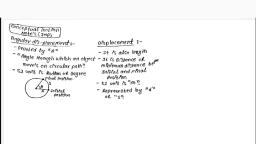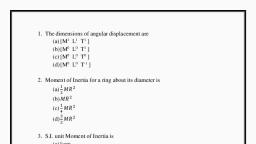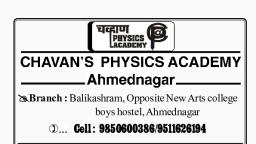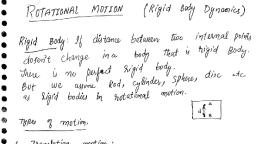Page 2 :
Q.1. What is the difference between revolution and, rotation of an object?, Ans: During revolution, the object (every particle in the, object) undergoes circular motion about some point, outside the object or about some other object. During, rotation, the motion is about an axis of rotation passing, through the object., , Q.5. Name and explain the rule used to determine the, direction of angular velocity., Ans: Right hand thumb rule., Explanation:, , Q.2 Can you recall? What is circular motion?, Ans: Motion of an object around a circular path is called as, circular motion., Q.3. State the characteristics of circular motion., Ans :, i), , Accelerated motion: As the direction of velocity, changes at every instant, it is an accelerated motion., , ii), , Periodic motion: During the motion, the particle, repeats its path along the same trajectory. Thus, the, motion is periodic., , Q.4. State the expression for tangential velocity (in, vector form) when a body is performing circular, motion. Also, express it in its magnitude., , Q.7. Explain the term uniform circular motion with the, help of an example., Ans:, i), During circular motion, if the linear speed of the particle, remains constant, it is called Uniform Circular, Motion(UCM)., , Ans :, i), , In vector form, tangential velocity is given by,, , ii), , The magnitude of v is given by, v = r, , To know the direction of , curl the fingers of the right, hand along the sense of rotation, with the thumb, outstretched. The outstretched thumb then gives the, direction of ., Q.6. How is angular velocity related with periodic time, and frequency?, Ans: Relation between angular velocity ( ), periodic time, (T) and frequency (n);, =2 n, , Note : Tangential linear velocity describes the motion of, an object along the edge of the circle -whose, direction at any given point on the circle is always, along the tangent to that point., ii), , iii), , In U.C.M. only the direction of its velocity changes at, every instant in such a way that the velocity is always, tangential to the path., The acceleration responsible for U.C.M. is the, centripetal or radial acceleration,, . For, UCM, its magnitude is constant and it is, 2, , Here, v = tangential (linear) velocity,,, = angular velocity,,, r = position vector (radius vector from the centree, of circular motion), 11 th (Sci.), , 2, , iv), , . It is always directed towards the, r, centre of the circular motion (along – r ), hence called, centripetal., Example: Circular motion of electron around nucleus., Rotional dnyanmics
Page 3 :
Q.8. Explain the term non-uniform circular motion, with the help of an example, Ans:, i), , During circular motion if the linear speed of the particle, varies, it is called non-uniform circular motion., , ii), , In case of non-uniform circular motion, the velocity is, still tangential, the centripetal or radial acceleration ac., is still there. However, for non-uniform circular motion,, the magnitude of is not constant., , iii), , The acceleration responsible for changing the magnitude, of velocity is directed along or opposite to the velocity,, hence it is always tangential and the acceleration is called, , Q.9. What is the difference between uniform circular, motion and non-uniform circular motion?, Ans:, Sr., No., , U.C.M., , Non-U.C.M., , i), , Circular motion with, constant angular speed is, known as uniform, circular motion, , Circular motion with, variable angular, speed is called as, non-uniform circular, motion., , ii), , For U.C.M,, , iii), , In U.C.M, work done by, tangential force is zero, , In U.C.M, work done, by tangential force is, not zero, , iv), , Example: Motion of, the earth around the sun., , Example: Motion of, a body on vertical, circle., , as tangential acceleration ar ., iv), , As magnitude of tangential velocity v is changing during, a non-uniform circular motion, the corresponding, angular velocity is also changing at every instant. This, is due to the angular acceleration,, , v), , vi., , dt, , ., , Though the motion is non-uniform, the particles are still, in the same plane. Hence, the direction of is still along, the axis of rotation. For increasing speed, it is along, the direction of ., , Example: When a fan is switched ON or OFF, the, speed of the particles of the fan go on increasing or, decreasing for some time, however their directions are, always tangential to their circular trajectories. During, this time, it is performing non-uniform circular motion., , 11 th (Sci.), , 3, , 0, , For non-U.C.M,, 0, , Q.10. Is there change in direction of angular velocity, and plane of rotation with respect to change in, direction of angular acceleration?, Ans: If the angular acceleration is along any direction other, than axial, it will change the direction of, , also. Which, , will change the plane of rotation as, perpendicular to the plane of rotation, , is always, , Q.11.What will be the direction of angular displacement, and angular velocity, if angular acceleration is, constant and is along the axis of rotation?, Ans : If the angular acceleration is constant and is along, the axis of rotation, then all , and will be directed, along the same axis., Q.12. Do you know real and pseudo forces, their origin, and applications?, Ans :, i), A force which is produced due to interaction between, the objects is called real force., Rotional dnyanmics
Page 4 :
Example:, a) The earth revolves around the sun in circular, path due to gravitational force of attraction between, the sun and the earth., b) A relative motion between two solid surfaces in, contact gives rise to a force friction., ii), A pseudo force is one which arises due to the, acceleration of the observer's frame of reference., Example :, a. When a vehicle moves along a curved road, a, passengerin the vehicle experiences a force in the, outward direction i.e., away from the centre of the, curved road. This is due to pseudo force., b. When we are travelling by a bus and if it stops, suddenly, we feel a push in forward direction., Q.13. Explain the concept of centripetal force., Ans:, i), Def. : The force acting along the radius and towards, centre of circle is called as centripetal force, ii), The force providing centripetal or radial acceleration, is called as centripetal or radial force., where, r = radius of circular path., , iv), v), , *, , *, , *, , *, , In magnitude,, , r, The direction of this force is along the radius and, towards centre (centre seeking)., Example: A stone tied at the end of a string is revolved, in a horizontal circle, the tension in the string provides, the necessary centripetal force., The word centripetal is NOT the name or type of, that force (like gravitational force, nuclear force,, etc). It is the adjective or property of that force., While performing circular or rotational motion, the, resultant of all the real forces acting upon the body, is (or, must be) towards the centre, hence we call, this resultant force to be centripetal force. Under, the action of this resultant force, the direction of, the velocity is always maintained tangential to the, circular track., The vice versa need not be true, i.e., the resultant, force directed towards the centre may not always, result into a circular motion., It occurs in an inertial frame of reference in which, we are observing that the body is performing a, circular motion., , 11 th (Sci.), , Ans:, i), , A force equal in magnitude to the resultant real force,, but directed opposite, i.e., away from the centre is called, centrifugal force., , 2, , mv 2, =, r, , ii), , In magnitude FCFF = mr, , iii), , It is a pseudo force arising due to the centripetal, acceleration of the frame of reference., , iv), , Example : A bucket full of water is rotated in a vertical, circle at a particular speed, so that water does not fall., This is because, weight of water is balanced by, centrifugal force acting on it., , Note :*, , The force acting on a particle performing U.C.M, which is along the radius and directed away from, centre of circle is called centrifugal force., , Q.15. Distinguish between centripetal force and, centrifugal force., , 2, , iii), , Q.14. Explain the concept of centrifugal force., , 4, , Ans: Difference between centripetal force and, centrifugal force., Sr., No., i), , ii), iii), , iv), , Centripetal force, , Centrifugal force, , Centripetal force is, directed along the radius, towards the centre of a, circle, It is a real force, It is considered in, inertial frame of, reference., In vector form, it is, given by, , Centrifugal force is, directed along the, radius away from the, centre of a circle, It is a pseudo force., It is considered in, non-inertial frame of, reference., In vector form, it is, given by, 2, , r, with usual notations., , r, with usual notations., , Q.16. Explain the concept of centrifugal and centripetal, force with the help of merry-go-round illustration., Ans :, i), In merry-go-round rotating with uniform speed, if one, closes his eyes then he / she feels that he / she is at rest., This is due to centrifugal force., Rotional dnyanmics
Page 5 :
ii), , Before merry-go-round reaches its uniform speed, one, experiences an outward pull as the centrifugal force is, greater than the resultant force towards the centre., iii), Hence, centrifugal force is a non-real force, but NOT, an imaginary force., iv) On reaching the uniform speed, in the frame of reference, of merry-go-round, this centrifugal force exactly, balances the resultant of all the real forces. The resultant, force in that frame of reference is thus zero. Thus, only, in such a frame of reference we can say that the, centrifugal force balances the centripetal force., v), It must be remembered that in this case, centrifugal force, means the ‘net pseudo force’ and centripetal force, means the ‘resultant of all the real forces’., Q.17. Match the column., Column-I, i) Centripetal force, ii) Centrifugal force, , Column-II, a. Net Pseudo force, b. Resultant of all the, real forces, c. Imaginary force, , Resultant force = –m, , ii), m, Note :-, , 2, , 2, , ii), , iii), , Ans : (i - b), (ii - a), Q.18. State the two ways of writing force equation for a, circular motion., Ans : Ways of witing force equation for a circular motion., i), , Q.20. Derive an expression for maximum possible speed, for a vehicle to move on horizontal unbanked road., Ans:, i), Consider vertical section of a car moving on a horizontal, circular track having a radius 'r' with 'C' as centre of, track., , iv), , v), , r, , r + (real forces) = 0, , mv 2, r, Dividing equation (2) by equation (1),, fs =, , Centripetal force (resultant of all real forces)= –m 2 r, The sum of centrifugal and cetripetal force for a system, is zero., Q.19. Activity., Attach a suitable mass to spring balance so that it, stretches by about half its capacity. Now whirl the spring, balance so that the mass performs,a horizontal motion., You will notice that the balance now reads more mass, for the same mass. Can you explain this?, Ans:, i), When the spring balance performs'horizontal motion,, the mass attached to the spring balance' experiences, centrifugal force., ii) Thus, the net force acting on the mass is the sum of, centrifugal force and its weight., Hence, the spring balance reads more mass when set, in horizontal circular motion., *, *, , 11 th (Sci.), , Forces acting on the car (considered to be a particle):, (a) Weight (mg), vertically downwards,, (b)Normal reaction (N), vertically upwards that, balances the weight, (c) Force of static friction (fs) between road and the, tyres., Since, normal reaction balances the weight, N = mg, ....(1), The friction over here is static friction which acts as, resultant centripetal force because it prevents the vehicle, from outward slipping or skidding., While working in the frame of reference attached, to the vehicle, the frictional force balances the, centrifugal force., , 5, , .....(2), , 2, , ......(3), vi., , vii., , For a given track, radius r is constant. For given vehicle,, mg = N is constant. Thus, as the speed v increases, the, force of static friction fs also increases., However, fs has an upper limit (fs)max= sN, where s is, the coefficient of static friction between road and tyres, of the vehicle. This imposes an upper limit to the speed, v. At the maximum possible speed,, , ....[From equations (2) and (3)], This is an expression for maximum possible speed for, a vehicle to move on a horizontal unbanked road., Rotional dnyanmics
Page 6 :
Q.21. While driving along an unbanked circular road, a, two-wheeler rider has to lean with the vertical., Why is it so? With what angle the rider has to, lean? Derive the relevant expression. Why such, a leaning is not necessary for a four wheeler?, Ans :, i), While going rqund a curve, the rider provides himself, the necessary centripetal force by leaning inward, on a horizontal track., ii), Consider a rider of weight mg taking a turn of radius 'r', with velocity v., iii), In order to provide the necessary centripetal force, the, rider leans through angle inwards as shown in the, figure, , iv), , v), , vi), , The rider is under the action of the following forces:, a. The weight 'mg' acting vertically downward at the, centre of gravity of two wheeler and the rider., b. The normal reaction 'N' of the ground on rider. It, acts along a line making angle with the vertical., The vertical component N cos of the normal reaction, N will balance the weight of the cyclist, while the, horizontal component N sin will provide the necessary, centripetal force to the cyclist., mv 2, N sin =, r, and, N cos = mg, Dividing equation (1) by equation (2),, , vii), , In case of four-wheeler, the normal reactions on the, pair of inner wheels and outer wheels produce a net, restoring torque which opposes the overturning torque, due to frictional forces., Q.22. We have mentioned about static friction between, road and the tyres. Why is it static? What about, the kinetic friction between road and the tyres?, Ans:, i), The patch of tyres (made of rubber) which is actually, touching the road is not moving with respect to the road., It is static for a certain period every revolution., ii), Hence, static friction acts between tyres of car and road, but not kinetic friction even when the tyres are rolling., Q.23. What do you do if your vehicle is trapped on a, slippery or a sandy road? What is the physics, involved?, Ans:, When a vehicle is trapped on a slippery or a sandy, road, an additional force is required so that it can, overcome the strong frictional force between the tyres, and slippery or sandy road., Q.24. What is meant by well of death? Where can it be, seen?, Ans:, i), Well of death is a vertical cylindrical wall of radius 'r', inside which a vehicle is driven in horizontal circles., ii), It can be seen while performing stunts., Q.25. Derive an expression for minimum safest velocity, of a body to move in well of death., , ......(1), i), ......(2), , N, N, 2, , ii), , rg, Therefore, the rider should bend through an angle,, iii), , 11 th (Sci.), , 6, , The forces acting on the vehicle (assumed to be a point), are :, a. Normal reaction (N) acting horizontally and towards, the centre,, b. Weight (mg) acting vertically downwards,, c. Force of static friction (fs) acting vertically upwards, between vertical wall and the tyres., It is static friction because it has to prevent the, downward slipping. Its magnitude is equal to mg, as, this is the only upward force., mg = fs, ....(1), Normal reaction (N) is thus the resultant centripetal, force (i.e., the only force that can balance the centrifugal, force)., Rotional dnyanmics
Page 7 :
ii), , 2, , iv), , ....(2), r, In order to continue the horizontal motion, force of static, friction fs should be always less than or equal to sN., , ....[From equation (1) and (2)], , r, , The minimum safest velocity of a body to move in, , rg, well of death is vmin =, Note :*, In such case, fs = sN is valid only for the minimum, speed as fs should always be equal to mg., *, During the derivation,, N should always be equal to, , r, , mv 2, r, , s, , *, , During revolutions in such a well, a two-wheeler/, four wheeler is never horizontal, else, the torque, due to its weight will topple it., *, The torque that balances the torque due to the, Weight is frictional force in this case., Q.26. Explain the concept of lower limit and upper limit, on the turning speed., Ans :, i), If a road is banked at 90°, it imposes a lower limit on, the turning speed., ii), For an unbanked road (banking angle = 0°), there is, an upper limit for the turning speed., iii), It means that for any other banking angle (0°< < 0°),, the turning speed will have the upper as well as the, lower-limit., Q.27. Why are curved roads banked?, Ans :, i), While taking a turn on a horizontal road, the force of, static friction between the tyres of the vehicle and the, road provides the necessary centripetal force (or, balances the centrifugal force)., 11 th (Sci.), , However, the frictional force is having an upper limit., Also, its value is usually not constant as the road surface, is not uniform., iii), Thus, in real life, we should not depend upon it, as it is, not reliable., iv) For this purpose, the surfaces of curved roads are tilted, with the horizontal with some angle ., v), This is called banking of a road or the road is said to be, banked,, vi) When the road is banked, the horizontal component, of the normal reaction provides the necessary centripetal, force required for circular motion of vehicle., Q.28. Derive expression for angle of banking when a, vehicle (consider to be a point) moves along a, curved banked road neglecting friction., Ans :, The vertical section of a vehicle on a curved road of, radius 'r' banked at an angle ' ' with the horizontal is, shown, in the figure., , 7, , ii), , iii), , iv), , vi), , Considering the vehicle to be a point and ignoring, friction (not eliminating) and other non-conservative, forces like air resistance, there are two forces acting, on the vehicle:, a. weight (mg), vertically downwards, b. normal reaction (N), perpendicular to the surface of, the road., As the motion of the vehicle is along a horizontal circle,, the resultant force must be horizontal and directed, towards the centre of the track. Hence, the vertical force, mg must be balanced., Thus, normal reaction (N) is resolved into,, a. N sin - along the horizontal,, b. N cos - along the vertical., The vertical component N cos balances the weight,, N cos = mg, .....(1), Horizontal component N sin being the resultant force,, must be the necessary centripetal force (or balance the, centrifugal force)., Rotional dnyanmics
Page 8 :
2, , r, Dividing equation (2) by equation (1),, , 2, , ......(2), vii), , 2, , tan, , rg, , viii), , This is an expression for angle of banking when a vehicle, moves along a curved banked road neglecting friction., Q.29. What is the need for lower and upper speed limit, for a vehicle moving on a banked road? Derive, expression for it., Ans:, i), If the vehicle is running exactly at the speed, , ....(1), r, The vertical components N cos and fs sin is, balanced by weight mg,, mg = N cos + fs sin, ...(2), For minimum possible speed, fs is maximum and equal, to sN., From equation (1) and (2),, , For s > tan , vmin = . This is true for most of the, rough roads, banked at smaller angles., ix), , For speeds, The component N sin, , , the forces acting on the vehicle are, , ii., iii., , iv., , force, , a. weight mg acting vertically downwards, b. normal reaction N acting perpendicular to the road., But in practice, vehicles never travel exactly with this, speed., Hence, for speeds other than this, the component of, force of static friction between road and the tyres helps, us, up to a certain limit., , ,, is less than the centrifugal, , 2, 2, , mv, r, 2, , r, , For speeds, The component N sin is greater than the centrifugal, , mv12, r, , force, , 2, , x., , r, xi., , In this case, the direction of force of static friction (fs), between road and the tyres is directed along the, inclination of the road, downwards., The horizontal component (fs cos ) is parallel to Nsin ., These two forces take care of the necessary centripetal, force (or balance the centrifugal force)., 2, , r, xii., v), , vi), , In this case, the direction of force of static friction (fs), between road and the tyres is directed along the, inclination of the road, upwards. Its horizontal, component (fs cos ) is parallel and opposite to Nsin ., These two forces take care of the necessary centripetal, force (or balance the centrifugal force)., , 11 th (Sci.), , 8, , xiii), , .....(3), , The vertical component, N cos balances the, component fs sin and weight 'mg'., N cos = fs sin + mg, mg = N cos – fs sin, For maximum possible speed, fs is maximum and equal, to sN., From equations (3) and (4),, Rotional dnyanmics
Page 9 :
If s = cot vmax = . But ( s)max = l.Thus, for, 45°,, vmax = . However, for heavily banked road, minimum, limit may be important., Note :*, Explanation for point (viii) :, Dividing equation (1) by equation (2),, , ..... (, , fs =, , s, , N), , fs =, , s, , N), , Dividing above equation by ‘N cos ’, s, s, , s, , rg, s, , *, , Explanation for point (xiii) :, Dividing equation (3) by equation (4),, , ..... (, Dividing above equation by ‘N cos ’, , Note :For a safer side, frictional force is not considered, as it is not enough and unreliable every time as it, changes when road becomes oily or wet in rainy, season., Q.31. State the following terms:, i., Pendulum, ii., Simple pendulum, iii. Conical pendulum, Ans :, i), A tiny mass (assumed to be a point object and called a, bob) connected to a long, flexible, massless, inextensible, string, and suspended to a rigid support is called a, pendulum., ii), If a tiny mass (assumed to be a point object and called, a bob) connected to a long, flexible, massless, in, extensible string, and suspended to a rigid support is, made to oscillate in a single vertical plane, it is said to, be a simple pendulum., iii), A tiny mass (assumed to be a point object and called a, bob) connected to a long, flexible, massless, inextensible, string, and suspended to a rigid support revolves in such, a way that the string moves along the surface of a right, circular cone of vertical axis and the point object, performs a uniform horizontal circular motion. Such a, system is called a conical pendulum, Q.32. Derive expression for time period of a conical, pendulum., Ans:, i), Consider the vertical section of a conical pendulum, having bob (point mass) of mass m and string of length, ' L'., ii), Here, is the angle made by the string with the vertical,, at any position (semi-vertical angle of the cone), iii) In a given position B, the forces acting on the bob are, a. its weight 'mg' directed vertically downwards, b. the force ‘T0’ due to the tension in the string, directed, along the string, towards the support A., , Q.30. ‘Use your brain power., As a civil engineer, you are given contract to construct, a curved road in a ghat. In order to obtain the banking, angle , you need to decide the speed limit. How will, you decide the values of speed v and radius r?, Ans: For a certain value of 'r', the value of safe speed on a, curved road in a ghat with banking angle will be,, , 11 th (Sci.), , 9, , Rotional dnyanmics
Page 10 :
iv), , v), , vi), , vii), , viii), , As the motion of the bob is a horizontal circular motion,, the resultant force must be horizontal and directed, towards the centre C of the circular motion., For this, tension (T0) in the string is resolved into, a. T0 cos : vertical component, b. T0 sin : horizontal component, The vertical component (T0 cos ) balances the weight, 'mg'., mg = T0 cos, ......(1), The horizontal component T0 sin then becomes the, resultant force which is centripetal., ....(2), mr 2 = T0 sin, Dividing equation (2) by equation (1),, , ......(3), , r cos, From the figure,, , c. Angle of inclination ( ): As increases, cos, decreases, hence, frequency of conical pendulum, increases with increase in ., i.e, n, , 1, cos, , (for 0 < < ), , ii), , Frequency at conical pendulum is independent of mass, of the bob., Note :Frequency of conical pendulum, , n, Q.34. Draw a diagram to represent conical pendulum in, a non-inertial frame of reference and state the, equation of centrifugal force on the bob, Ans :, , sin, r = L sin, From equation (3) and (4),, , .....(4), , g sin, , g, ix), , If T is the period of revolution of the bob, then, , Period,, , g, , Q.33. On what factors does the frequency of a conical, pendulum depends? Is it independent of some, factors?, a. Length of pendulum (L): Frequency of conical, pendulum increases with decrease in length of, pendulum., , In the frame of reference attached to the bob, the, centrifugal force should balance the resultant of all the, real forces (centripetal force) for the bob to be at rest., Equation for centrifugal force :, T 0 sin = mr 2, .....(in magnitude), Q.35. Is it possible for a string to become horizontal, during revolutions in a conical pendulum? Give, reasons., Ans: During revolutions, the string can never become, horizontal. This can be explained in two different ways., i), If the string becomes horizontal, the force due to tension, will also be horizontal. Its vertical component will then, be zero. In this case, nothing will be there to balance, mg., ii), For horizontal string, = 90°. This will indicate the, frequency to be infinite and the period to be zero, which, , i.e., n, , are impossible. Also, in this case, the tension, , b. Acceleration due to gravity (g): Frequency of, conical pendulum increases with increase in g. i.e.,, 11 th (Sci.), , 10, , and kinetic energy, , of the bob will be infinite., Rotional dnyanmics
Page 11 :
Q.36. State the two types of vertical circular motion, commonly observed in practice., Ans:, i), A controlled vertical circular motion such as a giant, wheel or similar games. In this case the speed is either, kept constant or NOT totally controlled by gravity., ii) Vertical circular motion controlled only by gravity. In, this case, one initially supply the necessary energy, (mostly) at the lowest point. Then onwards, the entire, kinetics is governed by the gravitational force. During, the motion, there is inter conversion of kinetic energy, and gravitational potential energy., Q.37. Using the energy conservation, derive the, expressions for the minimum speeds at different, locations along a vertical circular motion, controlled by gravity. Is zero speed possible at the, uppermost point? Under what condition/s? Also, prove that the difference between the extreme, tensions (or normal forces) depends only upon the, weight of the object., Ans:, i), Consider a bob (treated as a point mass) tied to a, (practically) massless, inextensible and flexible string., i), It is whirled along a vertical circle so that the bob, performs a vertical circular motion and the string rotates, in a vertical plane., , vi), , Uppermost position (A):, a. Both, weight (mg) and force due to tension (TA), are downwards, i.e., towards the centre. In this, case, their resultant is used only as the centripetal, force., b. Thus, if VA is the speed at the uppermost point,, mVA2, mg + TA =, ....(1), r, c. For minimum possible speed at this point (or if the, motion is to be realized with minimum possible, energy),TA = 0, , vii), , (vA)min = rg, ......(2), Lowermost position (B):, a. Force due to the tension, TB is vertically upwards,, i.e., towards the centre, and opposite to mg. In this, case, their resultant is the centripetal force., b. If VB is the speed at the lowermost point,, 2, B, , ....(3), r, c. While coming down from the uppermost to the, lowermost point, the vertical displacement is 2r and, the motion is governed only by gravity., d. Hence the corresponding decrease in the, gravitational potential energy is converted into the, kinetic energy., , .....(4), From equation (2) and (4),, , ......(5), iii), , iv., , v), , At any position of the bob, there are only two forces, acting on the bob:, a. weight (mg), vertically downwards, which is constant, b. the force due to the tension (T), directed along the, string and towards the centre. (Its magnitude changes, periodically with time and location.), As the motion is non uniform, the resultant of these two, forces is not directed towards the centre except at the, uppermost and the lowermost positions of the bob., At all the other positions, part of the resultant is, tangential and is used to change the speed., , 11 th (Sci.), , viii) Positions when the string is horizontal (C and D):, a. Force due to the tension is the only force towards, the centre as weight mg is perpendicular to the, tension., b. Thus, force due to the tension is the centripetal force, used to change the direction of the velocity and, weight mg is used only to change the speed., c. At midway position (C), while coming down, from the midway point to the lowermost point,, the vertical displacement is r., Hence, the corresponding decrease in the gravitational, P.E. is converted into K.E., , 11, , Rotional dnyanmics
Page 12 :
ii), , Any higher speeds than the minimum speeds at the, uppermost and the lowermost points obeying the, equation are allowed., , iii), , In reality, we have to continuously supply some energy, to overcome the air resistance., , mgr =, , Since,, , Q.40. What is meant by mass tied to a rod? How is it, different from mass tied to a string?, Ans :, Similarly, ix), , x), xi), , Similary, TC – TA – = TD – TA = 3 mg, Arbitrary positions:, a. Force due to the tension and weight are neither, along the same line, nor perpendicular,, b. Tangential component of weight is used to change, the speed., c. It decreases the speed while going up and increases, it while coming down., Practically, zero speed is possible at the uppermost, point only when mass is tied to a rod., Difference between the extreme tensions: Subtracting, equation (1) from equation (3),, , m, .....(6), r, Using equation (4) and rearranging, we get,, TB – TA = 6 mg, Hence, difference in tension at extreme positions, depends only on weight., Q.38. What will happen to the string if tension at the, uppermost point during vertical circular motion, becomes zero?, Ans: Tension at uppermost point can never be exactly equal, to zero, else, the string will slack., Q.39. Why is it not possible to determine the time, period or frequency of vertical circular motion., Ans: The position vector or velocity at any instant can be, determined using the energy conservation. But as the, function of the radius vector is not integrable (definite, integration is not possible), theoretically it is not possible, to determine the period or frequency. However,, experimentally the period can be measured., Note :i), None of the parameters (including the linear and, angular accelerations) are constant during such a, motion and hence kinematical equations are not, applicable., , i), , A bob (point mass) tied to a (practically massless and, rigid) rod and whirled along a vertical circle., , ii), , The basic difference between the rod and the string is, that the string needs some tension at all the points,, including the uppermost point while mass tied to a rod, doesn't need tension at any point., , Q.41. State the expression for difference in tension at, the lowermost and uppermost point when mass is, tied to a rod., Ans: Tlowermost – Tuppermost = 6 mg, Q.42. Match the columns, For mass tied to rod performing vertical, , TB – TA– 2 mg =, , 11 th (Sci.), , Ans: (i - b), (ii - c), Q.43. Write short note on sphere of death.(ce=lÙegieesue), i), , This is a popular show in a circus. During this, twowheeler rider (or riders) undergo rounds inside a hollow, sphere., , ii), , Starting with small horizontal circles, they eventually, perform revolutions along vertical circles., , iii) The dynamics of this vertical circular motion is the same, as that of the point mass tied to the string, except that, the force due to tension T is replaced by the normal, reaction force N., iv), , 12, , The linear speed is more for larger circles but angular, speed (frequency) is more for smaller circles (while, starting or stopping). This is as per the theory of conical, pendulum., Rotional dnyanmics
Page 13 :
Q.44. Explain the expression for upper limit on the speed, when vehicle is at the top of a convex overbridge., Ans:, i), Consider a vehicle at the top of a convex over bridge, as shown in the figure., , Q.46. Explain : Moment of Inertia as an Analogous, Quantity for mass, Ans : Moment of inertia of a rigid body about an axis of, rotation is defined as the sum of product of the mass of, each particle and the square of its perpendicular distance, from the axis of rotation. It is denoted by,, , ii), , iii), , iv., , During its motion (part of vertical circular motion),, forces acting on the vehicle are, a. weight (mg), b. normal reaction force (N), both along the vertical, line (topmost position)., The resultant of these two must provide the necessary, centripetal force (vertically downwards) if the vehicle, is at the uppermost position., Thus, if v is the speed at the uppermost point, 2, , v), vi), , r, As the speed is increased, N goes on decreasing., Normal reaction is an indication of contact., Thus, for just maintaining contact, N = 0. This imposes, an upper limit on the speed as, , Q.45. Use your brain power., i), What is expected to happen if one travels fast over, a speed breaker? Why?, Ans: As speed increases over the speed breaker, normal, reaction goes on decreasing leading to discontact of, tyres from the road., ii), How does the normal force on a concave, suspension bridge change when a vehicle is, travelling on it with constant speed?, Ans: When a vehicle moves on a concave bridge, , 2, , where, mi is mass of ith particle and ri = perpendicular, distance of ith particle from axis of rotation., Q.47. How moment of inertia in rotational motion is an, analogous quantity for mass in linear motion., Ans:, i), Angular displacement, angular velocity and angular, acceleration respectively replaces linear displacement,, linear velocity and linear acceleration for various, kinematical equations., ii), Also, torque is an analogous quantity for force., Expressions of linear.momentum, force (for a fixed, mass) and kinetic energy include mass as a common, term., iii), Hence, in order to have their rotational analogues, MI, acts as analogues quantity for mass., Note :If we open a door (with hinges), we give a certain, angular displacement to it. The efforts needed for, this depend not only upon the mass of the door, but, also upon the (perpendicular) distance from the axis, of rotation, where we apply the force. Thus, the, quantity analogous to mass includes not only the, mass, but also takes care of the distance wise, distribution of the mass around the axis of rotation., Q.48. Derive an expression for kinetic energy of a, rotating body., Ans :, i), Consider a rigid object rotating with a constant angular, speed about an axis perpendicular to the plane of, paper, , ii), , Normal force, N = mg cos, , r, As changes, normal reaction will also change., , 11 th (Sci.), , 13, , For theoretical simplification, let us consider the object, to be consisting of N particles of masses m1, m2, .....mN, at respective perpendicular distances r1, r2, .....rN from, the axis of rotation., Rotional dnyanmics
Page 14 :
iii), , iv), , v), , As the object rotates, all these particles perform UCM, with the same angular speed , but with different linear, speeds,, v1 = r1 , v2 =r2 , ......., vN= rN, Translational K.E. of the first particle is, , Similar will be the case of all the other particles., Rotational K.E. of the object, is the sum of individual, translational kinetic energies., Thus,, , Q.50. Write short note on moment of inertia of a ring., OR, Derive expression for moment of inertia of a ring, about an axis passing through centre and, perpendicular to the plane., Ans :, i), An object is called a uniform ring if its mass is, (practically) situated uniformly on the circumference of, a circle., ii), It is a two dimensional object of negligible thickness., , Rotational K.E.=, Rotational K.E.=, , 1, 2, , But,, iii), 1, Rotational K.E.= I, 2, Q.49. Explain the physical significance of moment of, inertia., Ans:, i), If M.I. replaces mass m and angular speed replaces, linear speed v, rotational, 1, K.E. = I is analogous to translational, 2, 1, 2, K.E.= mv, 2, ii), Thus, I is defined to be the rotational inertia or moment, of inertia (M.I.) of the object about the given axis of, rotation., iii), Moment of inertia of an object depends upon (i), individual masses and (ii) the distribution of these, masses about the given axis of rotation., iv) For a different axis, it will again depend upon the mass, distribution around that axis and will be different if there, is no symmetry., Note :For a homogeneous rigid object of mathematically, integrable mass distribution, the moment of inertia is to, be obtained by integration as, , . If integrable, , mass distribution is not known, it is not possible to obtain, the moment of inertia theoretically, but it can be, determined experimentally., 11 th (Sci.), , If it is rotating about its own axis (line perpendicular, to its plane and passing through its centre), its entire, mass M is practically at a distance equal to its radius R, from the axis. Hence, the expression for the moment of, inertia of a uniform ring of mass M and radius R is, I = MR2., Q.51. What do you mean by uniform disc?, Ans:, i), Disc is a two dimensional circular object of negligible, thickness., ii), It is said to be uniform, if its mass per unit area and its, composition is the same throughout., iii), , The ratio, , is called the suface, , density of disc., Q.52. Derive expression for moment of inertia of a, uniform disc about an axis passing through centre, and perpendicular to the plane., Ans :, i), Consider a uniform disc of mass M and radius R rotating, about its own axis, which is the line perpendicular to its, plane and passing through its centre., Surface density of disc,, ii), , iii), , 14, , As it is a uniform circular object, it can be considered, to be consisting of a number of concentric rings of radii, increasing from (practically) zero to R., One of such rings of mass 'dm' is shown by shaded, portion in the figure., Rotional dnyanmics
Page 15 :
iv), v), , vi), , vii), , Width of this ring is 'dr', which is so small that the entire, ring can be considered to be of average radius r., Area of this ring, A = (2 r)dr, , dm = (2 r)dr, As it is a ring, this entire mass is at a distance r from the, axis of rotation. Thus, the moment of inertia of this ring,, Ir = dm (r2), Moment of inertia (I) of the disc can now be obtained, by integrating Ir from r = 0 to r = R., , 2, , Note :In practical sence, dr is less than the least count of, the instrument that measures r, so that r is constant, for that ring., Q.53. Why is it -useful to define radius of gyration?, Ans :, i), Calculation of moment of inertia is possible only for, mathematically integrable geometrical shapes., ii), However, experimentally one can determine the moment, of inertia of any object., iii), It depends upon mass of that object and how that mass, is distributed from or around the given axis of rotation., iv) If one is interested in knowing only the mass distribution, around the axis of rotation, we can express moment of, inertia of any object as I = MK2, where M is mass of, that object., v), It means that the mass of that object is effectively, at a distance K from the given axis of rotation., vi) In this case, K is defined as the radius of gyration of the, object about the given axis of rotation., vii) In other words, if K is radius of gyration for an object,, I = MK2 is the moment of inertia of that object., 11 th (Sci.), , Q.54. State whether true or false. If false rewrite the, correct statement., Larger the value of radius of gyration, nearer is, the mass from the axis., Ans: False, Larger the value of radius of gyration, farther is the mass, from the axis., Q.55. Compare the radius of gyration of a uniform ring, and uniform disc. What can you inference from, it?, Ans:, i), Consider a uniform ring and a uniform disc, both of the, same mass M and same radius R., ii), Let Ir and Id be their respective moment of inertias., iii), If Kr and Kd are their respective radii of gyration,, then, Ir = MR2 = MKr2,, ....(1), Kr = R, 1, Id =, d, 2, R, Kd =, ......(2), 2, From equation (1) and (2),, Kd < Kr, iv) It shows mathematically that K is decided by the, distribution of mass., v), In a ring the entire mass is distributed at the distance, R, while for a disc, its mass is distributed between, and R., vi) Among any objects of same mass and radius, ring has, the largest radius of gyration and hence maximum M.I., Q.56. Define radius of gyration. On what factors does, it depend and it does not depend? Can you locate, some similarity between the centre of mass and, radius of gyration? What can you infer if a uniform, ring and a uniform disc have the same radius of, gyration?, Ans:, i), Radius of gyration of a body about its given axis is, defined as the distance between the axis of rotation, and a point at which the whole mass of the body is, supposed to be concentrated, so as to possess the, same moment of inertia as that of body about the, same axis., ii), Centre of mass of a body is a point at which the whole, mass of the body is supposed to be concentrated., iii), Mathematically the radius of gyration is the root mean, square distance of the object's parts from either its, centre of mass or a given axis., , 15, , Rotional dnyanmics
Page 16 :
iv), , v), , a., 1., 2., 3., b., , Radius of gyration depends upon,, distribution of mass of the body, position of axis of rotation, shape and size of the body, Radius of gyration of body is independent of total, mass of the body., If Kr = Kd,, , ii), , Axis ACB is passing through the centre of mass C of, the object, parallel to the axis MOP, and at a distance, h from it ( h = CO)., , iii), , Consider a mass element 'dm' located at point D., Perpendicular on OC (produced) from point D is DN., Moment of inertia of the object about the axis ACB is, , iv), i.e., Radius of disc is equal to 2 radius of ring., Q.57. State the conditions under which the theorems of, parallel axes and perpendicular axes are, applicable. State the respective mathematical, expressions., Ans:, i), In order to apply parallel axes theorem to any object,, we need two axes parallel to each other with one of, them passing through the centre of mass of the object., ii), Perpendicular axes theorem relates the moment of inertia, of a laminar object about three mutually perpendicular, and concurrent axes, two of them in the plane of the, object and the third perpendicular to the object., Laminar object is like a leaf, or any two dimensional, object, e.g., a ring, a disc, any plane-sheet, etc., iii), Mathematical expressions:, a. Parallel axes theorem: I0 = Ic + Mh2, b. Perpendicular axes theorem: Iz = Ix + Iy, Q.58. State and prove theorem of parallel axes about, moment of inertia., Ans: Statement : The moment of inertia (I0) of an object, about any axis is the sum of its moment of inertia, (Ic) about an axis parallel to the given axis, and, passing through the centre of mass and the product, of the mass of the object and the square of the, distance between the two axes. Mathematically, I0, = Ic + Mh2, Proof :, i), Consider an object of mass M. Axis MOP is any axis, passing through point O., 11 th (Sci.), , Ic =, , dm, and about the axis, , MOP it is Io =, , dm., , I0 =, , . . . .(using Pythagoras theorem in ADNC), , Now,, v), , NC is the distance of a point from the centre of mass., Any mass distribution is symmetric about the centre of, mass. Thus, from the definition of the centre of mass,, , I0 = Ic + Mh2., This is the mathematical form of the theorem of parallel, axes, Q.59. Use your brain power., In the figure given below, the point D is chosen such, that we have to extend OC for the perpendicular DN, to fall on it. What will happen to the final expression of, I0, if point D is so chosen that the perpendicular DN, falls directly on OC?, , 16, , Rotional dnyanmics
Page 17 :
iii), Ans: There will be no change in the expression of I0 i.e., the, expression will be same as I0 = Ic + Mh2., Q.60. State and prove theorem of perpendicular axes, about moment of inertia., Ans : Statement:, The moment of inertia of a laminar object about, an axis (Z) perpendicular to its plane is the sum of, its moment of inertia about two mutually, perpendicular axes (X and Y) in its plane, all the, three axes being concurrent., Mathematically, Iz = Ix + Iy, Proof :, i), Consider a rigid laminar object able to rotate about, three mutually perpendicular axes X, Y and Z., ii), Axes X and Y are in the plane of the object while the Z, axis is perpendicular to it, and all are concurrent at O., , iv), , Consider a mass element dm located at any point P., PM = y and PN = x are the perpendiculars drawn from, P respectively on the X and Y axes., The respective perpendicular distances of point P from, X, Y and Z axes will then be y, x and, , v), , ., , If Ix, Iy and Iz are the respective moment of inertia of, the body about x, y and z axes, then, Ix=, Iy =, Iz =, , = Ix + Iy, This is the mathematical form of the theorem of, perpendicular axes., Q.61. State an expression for M.I of thin uniform rod about an axis of rotation passing through its centre and, perpendicular to its length. Also deduce an expression for moment of inertia about an axis passing through, its one end and perpendicular to its length., Ans :, Expression for M.I. of thin uniform rod about, an axis passing through its centre and, perpendicular to its plane :, , Expression for M.I. of thin uniform rod about, an axis passing through its one end :, , i), , Let, L = length of rod AB, i) Let, L = length of rod AB, M = mass of the rod, M = mass of the rod, ZZ’ = axis passing through centre of rod, ZZ’ = axis passing through centre of rod, and perpendicular to the plane., and perpendicular to the plane., ii) The M.I. of a thin uniform rod about an axis, YY’ = axis passing through its one end., passing through its centre of mass and, ii) According to the theorem of parallel axes,, perpendicular to its length is given by,, I0 = Ic +Mh2, 2, , 2, , 12, , 2, , 2, , 12, , 2, , 4, , 2, 3 2 4 2, 12, 12, 3, Hence, M.I. of rod about an axis passing through, 2, , its one end is, , 11 th (Sci.), , 17, , ., Rotional dnyanmics
Page 18 :
YY' = Tangent, , Q.62.State an expression for moment of inertia of ring, about, i), an axis passing through its centre and, perpendicular to it., ii), its diameter., Ans :, i), Expression of M.I of thin ring about an axis, passing through its centre and perpendicular to, it:, a. Let, M = mass of ring, R = radius of ring, ZZ' = axis passing through the centre and, perpendicular to the plane, , a), , ii), , b. Since the ring is symmetrical about any of its diameter,, IX = IY = Id, where Id is M.I of ring about any of its diameter., c. Applying perpendicular axis theorem, IZ = IX + IY, I = Id + Id, , MR 2, Id =, 2, , to the plane of the ring, , Applying theorem of parallel axis,, IT = IC + Mh2, , ii), , b. The M.I of thin ring about an axis passing through, its centre and perpendicular to its plane is given by, ., IC = MR2, Expression of M.I of thin ring about its diameter:, a. Let, IX = M.I of ring about diameter XX', to XX', IY = M.Iof ring about YY', Iz = M.I of ring about ZZ', to plane, , ar, , b), , = MR2 + MR2, IT = 2MR2, Expression of M.I of thin ring about a tangent to the, circle of the ring:, Let, Id = M.I about diameter AB, IT = M.I about a tangent parallel to AB, , According to theorem of parallel axis,, IT = Id + Mh2 = Id + MR2...., 2, , But, I d, 2, 2, , 2, , Q.63. State an expression for moment of inertia of a thin, uniform disc about, i), an axis passing through its centre and, perpendicular to its plane., ii), its diameter., Ans:, i), Expression of M.I of uniform disc about an axis, passing through its centre and perpendicular to, its plane :, a. Let, M = mass of disc,, R = radius of disc, ZZ' = axis passing through the centre of disc and, perpendicular to the plane,, , Note :i), Expression for M.I of thin ring about a tangent, perpendicular to its plane:, Let, Ic = M.I of ring about axis ZZ',, IT = M.I of ring about a tangent,, 11 th (Sci.), , 18, , Rotional dnyanmics
Page 19 :
b), , The M. I of a thin uniform disc about an axis passing, through its centre and perpendicular to its plane is given, 1, MR2, 2, Expression of M.I of uniform disc about its, diameter:, Let, IX = M.I of disc about diameter XX',, IY = M.IofdiscaboutYY' ar to XX', IZ = M.I of disc about ZZ' ar to plane, Since the disc is symmetrical about any of its diameter,, IX = IY = Id, where Id is M.I of disc about any of its diameter., , The M. I of solid cylinder about its own axis of symmetry, is given by,, I=, , by, IC =, , ii), a., , b., , c., , *, , The M.I of solid cylinder about an axis passing through, its centre and perpendicular to its length is given by, , IZ = IX + IY, IZ = Id+ Id =2Id, , R 2 L2, I=M, +, 4 12, , 2, , 2, , MR, 4, Q.64. State an expression for moment of inertia of a solid, cylinder of uniform cross section about its own axis, of symmetry., Ans: Expression for M.I of solid cylinder about its own, axis of symmetry:, Let, M = mass of cylinder,, R= radius of cross section of cylinder, L= length of cylinder,, ZZ' = axis passing through its centre and ar to its, plane., Id =, , Q.64. State an expression for moment of inertia of a, uniform solid sphere about its tangent. Ans: M.I, of solid sphere about its tangent:, i), Let, I = M.I of solid sphere about its diameter ZZ'., IT = Moment of inertia of the sphere about tangent, YY'., ii), Applying theorem of parallel axis,, 2, 7, MR2 + MR2 = MR2, 5, 5, Enrich Your knowelge, M.I. of solid sphere about its diameter:, Let, M = mass of solid sphere, R = radius of sphere, ZZ' = axis of rotation, IT = IO + MR2 =, *, i), , ii), , 11 th (Sci.), , Enrich Your knowledge, M.I of solid cylinder about an axis passing through, its centre and perpendicular to its length:, Let, M = mass of cylinder, R = radius of cylinder, L = length of cylinder, ZZ' = axis passing through its centre and ar to its, length, , Applying perpendicular axis theorem,, , Id =, , 1, MR 2, 2, , 19, , The M.I of solid sphere about its own diameter is given, by,, 2, I = MR 2, 5, Rotional dnyanmics
Page 20 :
Q.66. Explain the analogous of angular momentum in, rotational motion to linear momentum in, translational motion., Ans:, i), The quantity in rotational mechanics, analogous to linear, momentum is angular momentum or moment of linear, momentum., ii), It is similar to the torque being moment of a force., iii), If p is the instantaneous linear momentum of a particle, undertaking a circular motion, its angular momentum, at that instance is given by, , iv), , , where r is the position vector from the axis, of rotation., In magnitude, it is the product of linear momentum, and its perpendicular distance from the axis of rotation., L = P × r sin, Where is the smaller angle between the directions, , of P and r ., The expression for angular momentum, L = I is, analogous to the expression, p = mv of linear, momentum, if the moment of inertia I replaces mass,, which is its physical significance., Q.67. Derive an expression that relates angular, momentum with the angular velocity of a rigid, body., Ans:, , v), vi), vii), , Linear momentum of the first particle is of magnitude, p1 = m1v1 = m1r1 . Its direction is along that of v1., Its angular momentum is thus of magnitude, L1 = p1r1 = m1r12, Similarly, L2 = m2 r22 , L3 = m3 r32 ,...., LN = mN rN2 ., , viii), , For a rigid body with a fixed axis of rotation, all these, angular momenta are directed along the axis of rotation,, and this direction can be obtained by using right hand, thumb rule, Q.68. Obtain an expression relating the torque with, angular acceleration for a rigid body., Ans:, i), Consider a rigid object rotating with a constant angular, acceleration ' ' about an axis perpendicular to the plane, of paper,, , v), , ii), , iii), , iv), i), , ii), , iii), , iv., , Consider a rigid object rotating with a constant angular, speed ' ' about an axis perpendicular to the plane of, paper., Let us consider the object to be consisting of N number, of particles of masses m1, m2, .....mN at respective, perpendicular distances r1, r2, .....rN from the axis of, rotation., As the object rotates, all these particles perform UCM, with same angular speed , but with different linear, speeds v1 = r1 ,, v2 = r2 , .....vN = rN ., , v), vi), , vii), viii), , Directions of individual velocities v1 , v 2 ,......v N , are, along the tangents to the respective tracks., , 11 th (Sci.), , 20, , Let us consider the object to be consisting of N number, of particles of masses m1, m2,.....MN at respective, perpendicular distances r1, r2,.....rN from the axis of, rotation., As the object rotates, all these particles perform circular, motion with same angular acceleration , but with, different linear (tangential) accelerations a1 = r1 , a2 =, r2 ,..., aN = rN ,etc., Force experienced by the first particle is,, f1 = m1a1 = m1r1, As these forces are tangential, the respective, perpendicular distances from the axis are r1, r2, ....rN., Thus, the torque experienced by the first particle is of, magnitude 1 = f1r1 = m1r12, Similarly, 2= m2r22 , 3 = m3r32 .. .. N = mNrN2, If the rotation is restricted to a single plane, directions, of all these torques are the same, and along the axis., Magnitude of the resultant torque is then given by where,, = 1 + 2 ..... N, where, I = m1r12 + m2r22....+ mNrN2 is the moment of, inertia of the object about the given axis of rotation., Rotional dnyanmics
Page 21 :
Q.69. State the analogous of torque in rotational motion, with force in linear motion., Ans: The relation = I is analogous to f = ma for the, translational motion if the moment of inertia I replaces, mass, which is its physical significance., Q.70. State and explain the principle of conservation of, angular momentum. Use a suitable illustration. Do, we use it in our daily life? When?, Ans: Principle: Angular momentum of an isolated system, is conserved in the absence of an external unbalanced, torque., Proof:, i), Angular momentum or the moment of linear momentum, of a system is given by,, , ii), , iii), , where r is the position vector from the axis of rotation, and p is the linear momentum., Differentiating with respect to time, we get,, , Now,, , dr, dt, , and, , dp, dt, , dL, dt, Now, , dL, dt, iv), , But,, , Thus, if, , v), , is the moment of force or torque ., , or L = constant ., , Hence, angular momentum L is conserved in the, absence of external unbalanced torque ., This is the principle of conservation of angular, momentum, analogous to the conservation of linear, momentum., Examples of conservation of angular momentum: During, some shows of ballet dance, acrobat in a circus, sports, like ice skating, diving in a swimming pool, etc., the, principle of conservation of angular momentum is, realized., , 11 th (Sci.), , vi), , Illustration:, Ballet dancers:, a. During ice ballet, the dancers have to undertake, rounds of smaller and larger radii,, b. The dancers come together by taking rounds of, smaller radius (near the centre)., c. In this case, the moment of inertia of their system, becomes minimum and the frequency increases,, to make it thrilling., d. While during outer rounds, the dancers outstretch, their legs and arms,, e. This increases their moment of inertia that reduces, the angular speed and hence the linear speed. This, is essential to prevent slipping., Q.71. Explain how diving in a swimming pool uses the, principle of conservation of angular momentum., Ans:, i), While on the diving board, the divers stretch their body, so as to increase the moment of inertia., ii), Immediately after leaving the board, they fold their body., This reduces the moment inertia considerably., iii), As a result, the frequency increases and they can, complete more rounds in air to make 'the show, attractive., iv) Again, while entering into water they stretch their body, into a streamline shape. This allows them a smooth entry, into the water., Q.72. Explain the relation between angular momentum, and frequency., Ans: Angular momentum is given by,, L = I = I( n, i), If the moment of inertia I is increased, the angular speed, and hence the frequency of revolution n decreases., ii), Also, if the moment of inertia is decreased, the frequency, increases., Q.73. Discuss the interlink between translational,, rotational and total kinetic energies of a rigid, object that rolls without slipping., Ans :, i), In the case of pure rolling, two motions are undertaking, simultaneously circular motion and linear motion., ii), Individual motion of the particles (except the one at the, centre of mass) is too difficult to describe., iii) However, for theory considerations we can consider, the actual motion to be the result of (i) circular motion, of the body as a whole, about its own symmetric axis, and (ii) linear motion of the body assuming it to be, concentrated at its centre of mass. In other words, the, centre of mass performs purely translational motion., , 21, , Rotional dnyanmics
Page 22 :
iv), v), vi), , Accordingly, the object possesses two types of kinetic, energies: rotational and translational K.E, Sum of rotational K.E. and translational K.E. is its total, kinetic energy., Consider an object of moment of inertia I, rolling, uniformly., Let,, v = Linear speed of the centre of mass, R = Radius of the body, = Angular speed of rotation of the body, M = Mass of the body, K = Radius of gyration of the body, Total kinetic energy of rolling, = Translational K.E. + Rotational K.E., , ii), iii), , iv), , As the objects starts rolling down, its gravitational, P.E. is converted into K.E. of rolling., Starting from rest, let v be the speed of the centre of, mass as the object comes down through a vertical, distance h., Total kinetic energy,, , E = mgh, , 2gh, , v, , v), This is an expression for kinetic energy during rolling, motion, Q.74. Explain the role of static friction in rolling motion., Ans:, i), Static friction is essential for a purely rolling motion. In, this case, it prevents the sliding motion. While rolling, down, the motion is initially a purely rolling motion that, later on turns out to be a sliding motion., ii), Similarly, if you push a sphere-like object along a, horizontal surface, initially it slips for some distance and, then starts rolling., Q.75. A rigid object is rolling down an inclined plane., Derive expressions for the acceleration along the, track and the speed after falling through a certain, vertical distance., Ans :, i), Consider a rigid object of mass m and radius R, rolling, down an inclined plane, without slipping. Inclination of, the plane with the horizontal is ., , Linear distance travelled along the plane is, s, , vi), vii), , During this distance, the linear velocity has increased, from zero to v., If a is the linear acceleration along the plane, v2 = u2+ 2as, 2as = v2 – u2, , a, , viii), , For pure sliding, without friction, the acceleration is g, sin and final velocity is, , 2gh . Thus, during pure, , rolling, the factor, , is effective for both the, , expressions., Note :For a rolling object, if the expression for moment, of inertia is of the form n (MR2), the numerical, K2, factor n gives the value of 2 for that object., R, 11 th (Sci.), , 22, , Rotional dnyanmics
Page 23 :
For example, for a uniform solid sphere,, , Hence, they have the same formula to their M.I., i.e., I =, , 1, MR2, 2, , Q.77. Read each statement below carefully and state,, with reasons, if it is true of false:, Similarly,, , i), , The net acceleration of a particle in circular motion, is always along the radius of the circle towards, the centre., , ii), , The acceleration vector of a particle in uniform, circular motion averaged over one cycle is a null, vector., , 2, , K, R2, , for a ring or a hollow cylinder, = for a uniform disc or a solid cylinder, Ans:, , = for a thin walled hollow spheree, *, *, , When a rod rolls, it is actually a cylinder that is, rolling., While rolling, the ratio 'Translational K.E.:, Rotational K.E.: Total K.E. is, , i), , The statement is false. The acceleration of the particle, performing circular motion is along the radius only when, particle is moving with uniform speed., , ii), , The statement is true. When we consider a complete, cycle, for an acceleration at any point of circular path,, there is an equal and opposite acceleration vector at a, point diametrically opposite to the first point, resulting, in a null net acceleration vector, , For example, for a hollow sphere,, Thus, for a rolling hollow sphere, Translational K.E.:, Rotational K.E.: Total Kinetic Energy, 1:1:, , =3:2:5, , Percentage wise, 60% of its kinetic energy is, translational and 40% is rotational., Q.76. Auniform disc and a hollow right circular cone have, the same formula for their M.I., when rotating, about their central axes. Why is it so?, Ans :, i), For a rotating object, if the expression for moment of, inertia is of the form n (MR2), the numerical factor n, , ii), , K2, gives the value of 2 for that object., R, A uniform disc and a hollow right circular cone has the, K2, same value of 2 ., R, i.e.,, , 11 th (Sci.), , 23, , Rotional dnyanmics
